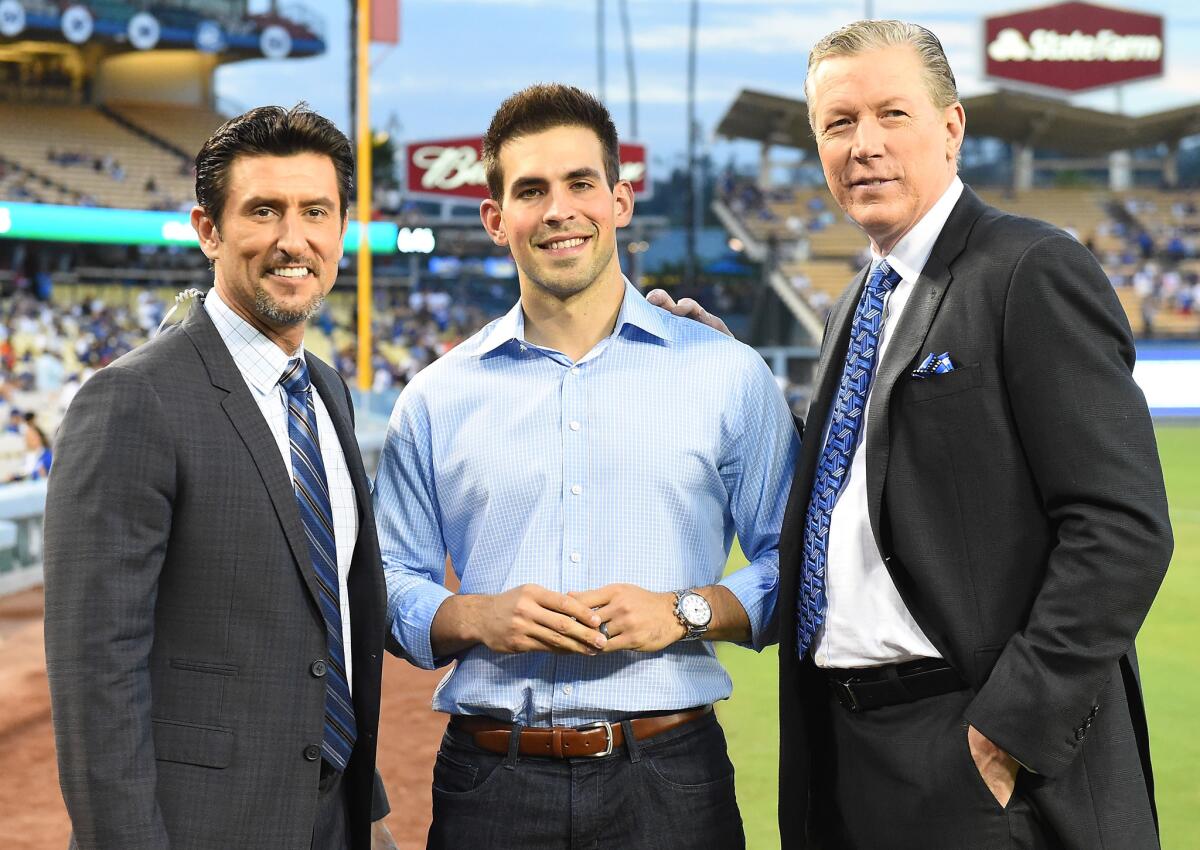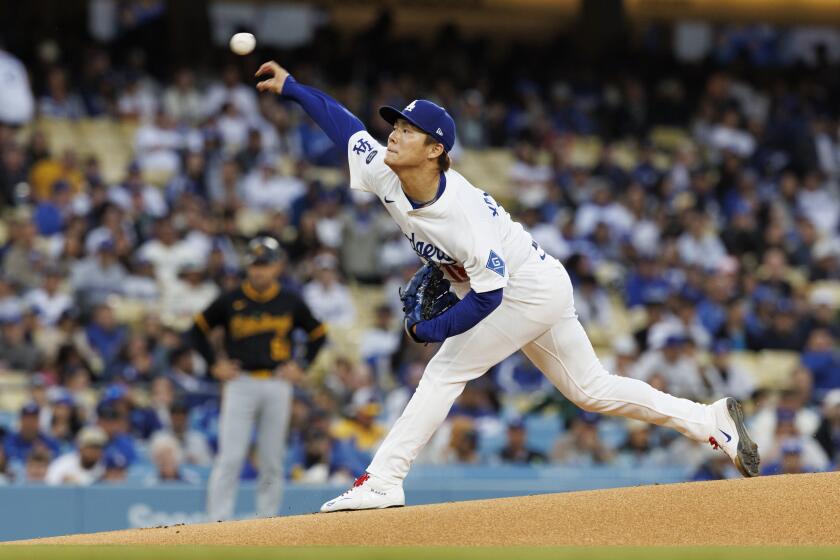Dodgers Dugout: What advice did Vin Scully pass on? Dodgers announcer Joe Davis answers your questions

- Share via
Hi, and welcome to another edition of Dodgers Dugout. My name is Houston Mitchell, and, learning from Corey Seager and Cody Bellinger, the Dodgers should get as many players whose names start with “Co” as they can. Cole Hamels, anyone?
Joe Davis answers your questions
You sent in hundreds of questions, and Dodgers announcer Joe Davis is here to answer some of them. I picked the most representative questions and sent them to Joe. He sent back his answers before the Dodgers’ series last week against the Cleveland Indians. If questions were similar I went with the person who emailed in the question first.
And thanks to Joe for taking time out of his busy schedule to answer these questions.
Tony Piscitelli: Have you had the opportunity to consult with Vin Scully?
Davis: Hi Tony -- Vin called me and welcomed me to the team the night before my hiring was announced a couple falls ago. Funny story about that -- not recognizing his number, I twice ignored his calls! You should’ve seen the look on my face when I listened to the voicemail and realized what I’d done.
We talked again just before this season began. His biggest advice was the same as Hall of Famer Red Barber gave him when he got started in 1950: “Be yourself. You bring one thing to the booth nobody else can, and that is you.”
Joe Meehan: Does your experience playing college football -- with the prep time outweighing the execution time -- help you in your work as a broadcaster? What is your day like preparing for a game?
Davis: I think my experience as an athlete helps in a number of ways. It was important when I was just starting out calling minor league baseball to have an understanding of how to act around the team and where I belonged in the clubhouse and on the buses and so on. I think it’s important now in the big moments of a game. I always prided myself on being cool and calm as a quarterback, and the same idea of controlling and channeling the adrenaline and slowing the heart rate when things got crazy as a player definitely applies when the game is on the line and, as a broadcaster, you’ve gotta keep your cool and capture the moment.
See below for a little detail on prep.
Michael D. Green: I’d guess that many fans have fantasized about being a sports announcer, partly because you guys make it look so easy. For one so young you have a pretty full résumé, but when did you know that you wanted to go pro?
Davis: For as long as I can remember considering what I wanted to do. As early as fourth or fifth grade, I paid as much attention to the guys calling the games as I did the actual game. There’s nothing wrong with not finding your career passion until later in life, but it definitely helped set me ahead of the curve knowing early on what I wanted to do. In a way, it helped guide my decisions. The football coach where I wound up going to college knew the way to my heart. His main recruiting pitch was that I could announce the school’s basketball games as a freshman.
Reed Rosien: Do you have any pregame routine as a broadcaster?
Davis: I’m usually at the park four hours before first pitch, but most of my work is done at that point. For example, I spent something like 10 hours reading up on the Cleveland Indians yesterday (on my flight home from doing a national game in Boston, with a few extra hours of work time thanks to a long delay). I research each player individually. I’m looking for the basics of what they’ve done in their careers. I’m looking for what their season has been like. And I’m looking for as many stories as I can dig up on each player to be able to share. Then there’s the reading to get caught up on the narratives surrounding the Indians as a team throughout the year and entering the Dodgers’ series with them.
Keeping with the Indians series as the example -- now that I’m on the charter to Cleveland, I’m doing my last prep work on the series -- who’s hot/not in the preceding days, etc. In the morning before the first game of the series, I’ll update my notes on Clayton Kershaw, and I’ll study up on the Indians starter, Trevor Bauer. I’ll read all the stories on the Indians in their local publications/websites from that day. I’ll do the same for the Dodgers.
Up next will be the Mets, so throughout this week I’ll be starting this whole same process learning about their team and the players’ stories.
Once at the park, I read through team-supplied game notes, fill out my scorecard, hang by the cage during batting practice to visit with the players (and hopefully pick up a nugget or two to pass along to the viewers that night), review all the notes I’ve gathered leading up, eat some dinner, throw on some war paint (makeup), and then off we go.
Joan Kobori: Where did you gain your baseball knowledge, and do you have staff help collect info on player history?
Davis: I think one of the great things about baseball is that you can learn something new every day. There’s a funny little saying in our business: You spend a week preparing to call a football or basketball game. You spend a lifetime preparing to call a baseball game (insert joke here about how I haven’t prepared for that long).
We have an incredible behind-the-scenes crew that supports us, led by our producer Mike Levy and our director Dustin Denti. Those two guys are as good as anyone in the business, and the production crew in L.A. under them is second to none. In the booth with us, we have Mr. Do Everything Boyd Robertson, statistician Brian Hagan, audio extraordinaire Dave Wolcott, and several others.
As far as the stories, though -- no, we’ve gotta find those ourselves. I mentioned above the work I do to find stories on the players; I also try to be curious about things from the game’s long history that I think you at home might find enjoyable or interesting.
Kris Kemp: Joe do you prefer working alone, with one other announcer or with two other announcers? Why?
Davis: I actually did two years of minor league baseball solo (many do at that level; the Montgomery Biscuits couldn’t afford Orel Hershiser’s salary). I don’t think you’ll ever see someone do it in the majors again like we had with Vin. As far as three-man booth goes -- I have nothing against it (I had a lot of fun last year with Orel and Nomar Garciaparra), but I think two is probably the sweet spot. Watching baseball is a passive experience in a lot of ways, and three people tends to be too much for that kind of easy listening experience.
Javier Sanchez: How do your fellow announcers know what pitch a pitcher throws (fastball, cut fastball, slider, etc.)? Do you read catcher’s sign or do you judge your call by the balls movement?
Davis: It’s important to first know what pitches a guy throws. Based off that knowledge, I make that determination watching the pitches come home in my monitor (same shot you see at home). I shift my eyes to the field when the ball is put in play.
A side note to that: The best way to judge how well a fly ball is hit (and in my case, the way to decide how excitedly to build my call) is to watch the fielder react to it. He’ll tell you how hard it’s hit, and me how excited to get.
Larry Spindler: Whatever has happened to Andre Ethier? Is he ever going to play for the Dodgers again?
Davis: Andre is still working through some nagging lower back/hip pain. It’s such a bummer, the injury issues for him the last two years. Last year it was the unlucky broken leg during spring training. This year, he just can’t seem to shake it yet. Last I heard, it’s bothering him most while running. The hope is to have him back this year. Time will tell when that might be.
Kent Dugan: Hi, Joe. Even though I miss Vin I love what you bring to the table with Orel. You two are great together. My question is in regard to the horrible strike zones that umpires seem to have. Do you think that MLB will eventually go to some form of tech for balls and strikes? It really is amazing seeing how many strikes are called or missed in the average game.
Davis: I understand the appeal -- we have the technology, let’s get it right. But I would hate to mess with the aesthetics of the game. It’s one of the little things that make baseball beautiful: each umpire’s unique punchouts and barks, the complaining from the hitters, the exploiting of that day’s zone. Kinda goes back to the idea of baseball being a game where every day could show us something new -- I’m not a fan of anything that dampens that.
That said, I won’t be surprised if we get electronic balls/strikes at some point.
H. Brown: The DH rule was put into effect in 1973. With inter-league play now taking place at a much larger scale, how much longer do we have to tolerate the two leagues playing on an uneven playing field?
Davis: I don’t see this one changing any time soon. And, really, I think the advantage of National League pitchers having experience hitting (over their AL counterparts during interleague games in NL parks) is pretty small. NL pitchers are hitting .124. AL pitchers are hitting .099. For whatever it’s worth, the AL has won the majority of all-time interleague contests.
Roger Ball: After 59 years of listening to Vin, I was so used to him working alone. He spoke directly to the fans, instead the fans listening in on a conversation in the booth. No reflection on Orel or Nomar, who both do a great job, but have you considered working alone? I like your style and I believe you are the man who could do it.
Davis: Thanks Roger. As I mentioned, I did a couple years of minor league baseball alone. I totally get the appeal from a fan’s standpoint. I just don’t think it ever happens again. Vin made it sound easy. Over a 162-game season, it definitely wouldn’t be. Speaking from my situation, I think one of the worst things I could do would be to flat out try to be Vin. It’s not possible. Doing a solo booth would, in a lot of ways, force one to completely mimic Vin’s style. It was so perfect, but so uniquely Vin.
I wrote a little bit on preparation above. Admittedly, I prepare for these Dodger games completely differently than I’ve ever prepped for anything else. On my national broadcasts, the audience is often most interested in what the teams are doing and what the players are doing at this point in the season. Big picture. So I prepare to give them that. But, because Los Angeles has been spoiled by Vin’s style for as long as it’s had the Dodgers, the audience here desires something a little different. There’s a difference in trying to be Vin and trying to learn from what people loved about Vin. My preparation for Dodger broadcasts is much more about digging up player background stories than it is “what is this guy’s batting average,” because that’s what this city has grown to love and expect.
The obscure Dodgers record of the week
Which Dodgers pitcher has the all-time highest strikeouts per nine innings rate with the team, with a minimum of 400 innings pitched? Kenley Jansen, with a rate of 13.98. Here’s the top 10:
1. Kenley Jansen, 13.98
2. Eric Gagne, 10.38
3. Clayton Kershaw, 9.80
4. Sandy Koufax, 9.28
5. Hideo Nomo, 8.87
6. Zack Greinke, 8.29
7. Chan Ho Park, 8.28
8. Darren Dreifort, 8.27
9. Kevin Brown, 8.09
10. Chad Billingsley, 7.94
The highest Brooklyn Dodger is Dazzy Vance, who is 29th overall at 6.26
The bottom 10:
1. Sloppy Thurston, 1.79
2. Rube Erhardt, 1.99
3. Freddie Fitzsimmons, 2.25
4. Sherry Smith, 2.26
5. Jack Coombs, 2.38
6. Jim Pastorius, 2.54
7. Kaiser Wilhelm, 2.57
8. Curt Davis, 2.60
9. Tot Pressnell, 2.61
10. Oscar Jones, 2.64
The lowest L.A. Dodger is Rick Sutcliffe who is 46th lowest at 4.33. In all, 117 Dodgers have pitched at least 400 innings with the team.
All these numbers, and more, can be found at baseball-reference.com.
Next series
Monday, 7 p.m. PDT, New York Mets (Zack Wheeler) at Dodgers (Brandon McCarthy)
Tuesday, 7 p.m. PDT, New York Mets (Matt Harvey) at Dodgers (Rich Hill)
Wednesday, 7 p.m., New York Mets (Steven Matz) at Dodgers (Alex Wood)
Thursday, 7 p.m., New York Mets (Robert Gsellman) at Dodgers (Hyun-jin Ryu)
Note: Pitchers are subject to change.
And finally
There will be no newsletter Friday as I take a little time off. The next newsletter will be next Monday.
Have a comment or something you’d like to see in a future Dodgers newsletter? Email me and follow me on Twitter:@latimeshouston
Twitter: @latimeshouston
ALSO
Enrique Hernandez helps Dodgers hang on to beat Reds, 8-7
Dodgers President Stan Kasten understands the task before Jeanie Buss
Dodgers’ Logan Forsythe tries to get a line on his hitting
More to Read
Are you a true-blue fan?
Get our Dodgers Dugout newsletter for insights, news and much more.
You may occasionally receive promotional content from the Los Angeles Times.









